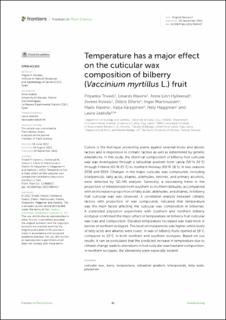| dc.contributor.author | Trivedi, Priyanka | |
| dc.contributor.author | Klavins, Linards | |
| dc.contributor.author | Hykkerud, Anne Linn | |
| dc.contributor.author | Kviesis, Jorens | |
| dc.contributor.author | Elferts, Didzis | |
| dc.contributor.author | Martinussen, Inger | |
| dc.contributor.author | Klavins, Maris | |
| dc.contributor.author | Karppinen, Katja | |
| dc.contributor.author | Häggman, Hely | |
| dc.contributor.author | Jaakola, Laura | |
| dc.date.accessioned | 2022-12-29T10:01:11Z | |
| dc.date.available | 2022-12-29T10:01:11Z | |
| dc.date.created | 2022-11-21T09:18:59Z | |
| dc.date.issued | 2022-09-20 | |
| dc.identifier.citation | Frontiers in Plant Science. 2022, 13 . | en_US |
| dc.identifier.issn | 1664-462X | |
| dc.identifier.uri | https://hdl.handle.net/11250/3039702 | |
| dc.description.abstract | Cuticle is the first layer protecting plants against external biotic and abiotic factors and is responsive to climatic factors as well as determined by genetic adaptations. In this study, the chemical composition of bilberry fruit cuticular wax was investigated through a latitudinal gradient from Latvia (56°N 24°E) through Finland (65°N 25°E) to northern Norway (69°N 18°E) in two seasons 2018 and 2019. Changes in the major cuticular wax compounds, including triterpenoids, fatty acids, alkanes, aldehydes, ketones, and primary alcohols, were detected by GC-MS analysis. Generally, a decreasing trend in the proportion of triterpenoids from southern to northern latitudes, accompanied with an increase in proportion of fatty acids, aldehydes, and alkanes, in bilberry fruit cuticular wax was observed. A correlation analysis between climatic factors with proportion of wax compounds indicated that temperature was the main factor affecting the cuticular wax composition in bilberries. A controlled phytotron experiment with southern and northern bilberry ecotypes confirmed the major effect of temperature on bilberry fruit cuticular wax load and composition. Elevated temperature increased wax load most in berries of northern ecotypes. The level of triterpenoids was higher, while levels of fatty acids and alkanes were lower, in wax of bilberry fruits ripened at 18°C compared to 12°C in both northern and southern ecotypes. Based on our results, it can be postulated that the predicted increase in temperature due to climate change leads to alterations in fruit cuticular wax load and composition. In northern ecotypes, the alterations were especially evident. | en_US |
| dc.language.iso | eng | en_US |
| dc.publisher | Frontiers Media | en_US |
| dc.rights | Navngivelse 4.0 Internasjonal | * |
| dc.rights.uri | http://creativecommons.org/licenses/by/4.0/deed.no | * |
| dc.title | Temperature has a major effect on the cuticular wax composition of bilberry (Vaccinium myrtillus L.) fruit | en_US |
| dc.title.alternative | Temperature has a major effect on the cuticular wax composition of bilberry (Vaccinium myrtillus L.) fruit | en_US |
| dc.type | Peer reviewed | en_US |
| dc.type | Journal article | en_US |
| dc.description.version | publishedVersion | en_US |
| dc.rights.holder | © 2022 Trivedi, Klavins, Hykkerud, Kviesis, Elferts, Martinussen, Klavins, Karppinen, Häggman and Jaakola | en_US |
| dc.source.pagenumber | 13 | en_US |
| dc.source.volume | 13 | en_US |
| dc.source.journal | Frontiers in Plant Science | en_US |
| dc.identifier.doi | 10.3389/fpls.2022.980427 | |
| dc.identifier.cristin | 2077002 | |
| dc.relation.project | EC/H2020/713606 | en_US |
| dc.source.articlenumber | 980427 | en_US |
| cristin.ispublished | true | |
| cristin.fulltext | original | |
| cristin.qualitycode | 2 | |

